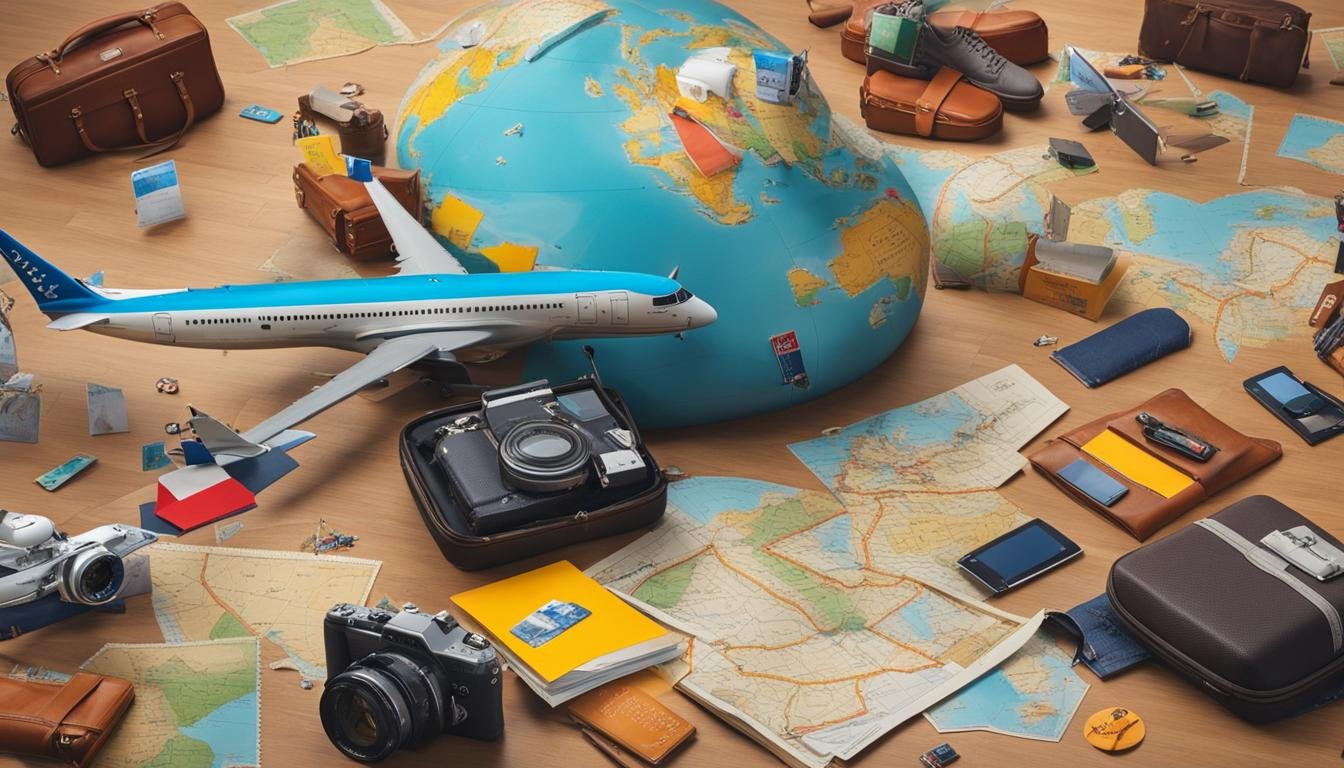Welcome to our comprehensive guide on mastering cultural etiquette! In today’s interconnected world, cross-cultural communication has become increasingly important. Understanding and respecting different cultural norms and social customs can make a significant difference in your interactions with people from diverse backgrounds. Whether you’re engaging in international business or navigating workplace dynamics, cultural etiquette plays a crucial role in building relationships and fostering effective communication.
Key Takeaways:
- Cultural etiquette is essential for making a good first impression in cross-cultural interactions.
- Mastering cultural etiquette helps in building relationships, avoiding misunderstandings, and fostering effective communication.
- Different countries have unique business etiquette practices, including punctuality, dress codes, physical contact, and gift-giving customs.
- Cultural etiquette also extends to the workplace, influencing communication styles, time management, and power dynamics.
- To navigate workplace cultural etiquette, it is important to be culturally competent, learn about other cultures, and encourage open-mindedness.
By understanding and respecting cultural etiquette, you can create a positive work environment, project a professional image, and establish a strong global presence. Let’s dive deeper into the world of cultural etiquette and explore its significance in various aspects of our lives.
The Importance of Cultural Etiquette in International Business
When conducting business internationally, cultural etiquette plays a vital role in building successful relationships and fostering effective cross-cultural communication. Cultural awareness and sensitivity are key elements in navigating the intricacies of intercultural etiquette.
Having a deep understanding of cultural norms and practices greatly benefits businesses seeking to expand their global presence. By demonstrating respect and consideration for different customs, companies can avoid potential misunderstandings and build trust with international partners and clients.
Intercultural etiquette involves more than just knowing the basic do’s and don’ts of a particular culture. It requires a genuine appreciation for the values, beliefs, and social customs of others. This awareness allows businesses to adapt their practices in ways that align with local expectations and preferences.
Intercultural etiquette involves more than just knowing the basic do’s and don’ts of a particular culture. It requires a genuine appreciation for the values, beliefs, and social customs of others.
The Benefits of Cultural Awareness
Developing cultural awareness enables businesses to navigate the complexities of global markets with ease. It allows them to tailor their marketing strategies, product offerings, and communication styles to suit the specific needs and preferences of diverse cultures. By embracing cultural sensitivity, companies can enhance their reputation and better position themselves for success in international business endeavors.
| Cultural Awareness | Cultural Sensitivity | Intercultural Etiquette |
|---|---|---|
| Understanding different cultural norms | Respecting cultural differences | Adapting to local customs |
| Building relationships with international partners | Avoiding cultural misunderstandings | Fostering effective communication |
| Enhancing reputation in global markets | Promoting diversity and inclusion | Creating a positive business image |
By prioritizing cultural awareness, sensitivity, and intercultural etiquette, businesses can navigate the global landscape with confidence while establishing themselves as respected global players.

Key Differences in Business Etiquette around the World
Different countries have unique business etiquette practices that can greatly impact successful cross-cultural interactions. Understanding these key differences is essential for professionals engaging in international business ventures. From punctuality and business wear to physical contact and gift-giving customs, here are some important variations to consider:
Punctuality
Punctuality holds different levels of importance in different cultures. For example, in Germany, being on time is highly valued and considered a sign of respect and professionalism. On the other hand, in Brazil, it is common for meetings to start later than the scheduled time, and arriving a few minutes late is generally acceptable.
Business Wear
Appropriate business attire varies across cultures. In France and Italy, dressing well and stylishly is highly regarded, while in more conservative cultures like China, modest and traditional attire is expected. It is crucial to research and adapt to the local dress code to make a positive impression in business settings.
Physical Contact
The level of physical contact in business interactions also differs. In China, physical contact, such as handshakes or hugs, may be discouraged in professional settings. In contrast, countries like Brazil embrace physical contact as a way of expressing warmth and friendliness. Understanding these cultural norms helps to avoid potential misunderstandings or discomfort.
Gift-Giving
Gift-giving customs vary widely across cultures, and it is important to approach this practice with sensitivity and respect. For example, in Japan, gifts are often presented with both hands and should be wrapped beautifully. In contrast, in the United States, gifts are typically opened in front of the giver. Understanding these customs can help build stronger relationships and demonstrate cultural awareness.
| Punctuality | Business Wear | Physical Contact | Gift-Giving | |
|---|---|---|---|---|
| Germany | Highly valued | Professional and conservative | Minimal physical contact | Appreciate punctuality and thoughtful gifts |
| Brazil | Less strict | Stylish and casual | Embrace physical contact | Personalized gifts are well-received |
| France | Moderate importance | Fashionable and sophisticated | Moderate physical contact | Appreciate high-quality gifts |
| China | Moderate importance | Conservative and modest | Discouraged in professional settings | Symbolic and thoughtful gifts |
These examples highlight just a few of the many business etiquette differences that exist around the world. Adapting to these practices demonstrates cultural intelligence and respect for diversity, ultimately leading to more successful international business relationships.
Navigating Cultural Etiquette in the Workplace
Effective communication is a cornerstone of workplace success, but it becomes even more complex when navigating different cultural etiquette norms. Understanding and adapting to diverse communication styles is crucial for fostering collaboration in a multicultural environment.
“In cross-cultural workplaces, it is essential to recognize that communication styles can vary significantly,” says Dr. Sarah Chang, an expert in intercultural communication. “Some cultures prioritize direct and assertive communication, while others value indirect and harmonious interactions.”
Time management is another aspect influenced by cultural etiquette. In some cultures, being punctual is highly valued, while in others, a more relaxed approach to time is acceptable. These differences can lead to misunderstandings and frustrations if not acknowledged and addressed.
Power and authority dynamics also vary across cultures, impacting workplace interactions. Some cultures emphasize hierarchical structures and deference to authority figures, while others embrace a more egalitarian approach. Awareness of these dynamics is crucial to navigate power relations respectfully and foster inclusive environments.

Communication Styles in Different Cultures
| Culture | Communication Style |
|---|---|
| United States | Direct and assertive |
| Japan | Indirect and nuanced |
| Germany | Clear and concise |
| Brazil | Expressive and animated |
Understanding and adapting to communication styles, time management practices, and power dynamics are essential for successful collaboration and productivity in a diverse workplace. By valuing and respecting cultural differences, individuals and organizations can create an inclusive environment that harnesses the strengths of its diverse workforce.
Tips for Mastering Workplace Cultural Etiquette
Mastering workplace cultural etiquette is essential for creating a harmonious and inclusive work environment. It requires cultural competence, open-mindedness, and a desire to learn about other cultures. By developing these skills, individuals can navigate cultural differences with respect and understanding, fostering effective teamwork and communication.
One key aspect of workplace cultural etiquette is cultural competence. This involves learning about the customs, traditions, and communication styles of different cultures. By gaining knowledge about other cultures, individuals can better understand their colleagues’ perspectives and avoid misunderstandings. Cultural competence also involves being open-minded and willing to embrace diversity in the workplace, appreciating the unique contributions that individuals from different backgrounds bring to the table.
Language learning is another valuable tool for workplace cultural etiquette. While it may not be feasible to become fluent in every language, learning a few key phrases can go a long way in showing respect and building rapport. Simple greetings and phrases like “thank you” and “please” can create a positive impression and demonstrate a willingness to engage with colleagues from different cultures.
Benefits of Workplace Cultural Etiquette
“Cultural competence and open-mindedness in the workplace lead to improved collaboration, higher job satisfaction, and increased productivity.” – HR Manager, ABC Company
Workplace cultural etiquette has numerous benefits. It promotes effective communication and collaboration, as individuals with cultural competence can navigate differences in communication styles and adapt their approach accordingly. It also fosters a positive work environment by promoting respect and understanding among colleagues. When employees feel valued and respected for their cultural backgrounds, they are more likely to be engaged and motivated, leading to increased job satisfaction and productivity.
In summary, mastering workplace cultural etiquette requires cultural competence, open-mindedness, and a willingness to learn about other cultures. By embracing diversity, learning key phrases of other languages, and practicing respect and understanding, individuals can create a positive work environment that fosters effective communication and collaboration. Workplace cultural etiquette is not only essential for individuals to thrive in a diverse workforce but also for businesses to create a strong global presence.
The Impact of Business Etiquette on Professional Image
When it comes to professional success, business etiquette plays a vital role in shaping one’s professional image. Demonstrating punctuality, dressing professionally, using proper greetings, and maintaining eye contact are essential practices that contribute to a positive professional image.
Punctuality is highly valued in the business world as it shows respect for others’ time and demonstrates reliability. Arriving on time for meetings and appointments is crucial in building trust and credibility. Being punctual also allows for a smooth flow of business interactions and avoids unnecessary delays.
Dressing professionally is another key aspect of business etiquette. The way we dress sends a powerful visual message about our professionalism and attention to detail. Dressing appropriately for the occasion and adhering to the dress code expectations of the workplace or business setting can significantly impact how others perceive us.
Using proper greetings and maintaining eye contact are also important elements of business etiquette. Greeting others with a warm and friendly demeanor sets a positive tone for the interaction and fosters good rapport. Similarly, maintaining eye contact during conversations shows attentiveness and engagement, conveying respect and interest in the conversation.
By practicing these business etiquette practices, individuals can establish a professional image that garners respect and trust from colleagues, clients, and business partners. These practices not only contribute to successful business relationships but also pave the way for personal and professional growth.
Essential Business Etiquette Practices
Effective business etiquette is crucial for creating a positive and respectful work environment. It involves practicing active listening, refraining from interrupting others, sending thoughtful and clear emails, and treating conversations with respect. These practices not only enhance communication and collaboration but also demonstrate professionalism and consideration for others.
Active listening is a fundamental skill that allows individuals to fully understand and engage with the speaker. It involves giving undivided attention, maintaining eye contact, and providing verbal and non-verbal feedback. By actively listening, we show respect for others’ perspectives and foster meaningful connections.
Another important aspect of business etiquette is refraining from interrupting others. Interrupting can be perceived as disrespectful and dismissive. It is essential to give others the opportunity to express their thoughts and ideas without interruption. This practice promotes a collaborative and inclusive environment.
When it comes to email communication, sending thoughtful and clear messages is key. It is important to consider the recipient’s perspective and provide all the necessary information in a concise and organized manner. Proofreading emails for clarity and tone before sending them helps avoid misunderstandings and ensures effective communication.
Essential Business Etiquette Practices:
- Practice active listening and give undivided attention to the speaker.
- Avoid interrupting others and provide space for everyone to express their thoughts.
- Send thoughtful and clear emails, considering the recipient’s perspective.
- Treat conversations with respect and maintain a professional and inclusive tone.
In summary, mastering essential business etiquette practices contributes to a positive work environment and effective communication. By actively listening, refraining from interrupting, sending thoughtful emails, and treating conversations with respect, individuals can foster strong relationships, promote collaboration, and demonstrate professionalism in the workplace.
Cultural Etiquette Tips for International Trade Shows
Participating in international trade shows provides a valuable opportunity to showcase products or services to a global audience. To make a positive impression and build successful international connections, it is crucial to understand and respect cultural norms. By adapting dress codes, practicing effective communication, being aware of gift-giving customs, and following appropriate business card etiquette, Indian exhibitors can navigate cultural differences and create meaningful business relationships.
Dress Code
Cultural norms surrounding dress code can vary significantly across different countries and regions. It is essential to research and understand the cultural expectations of the specific trade show location. Adapting dress codes to align with local customs shows respect and can help build rapport with potential business partners. For example, in some countries, such as Japan, formal attire is expected, while business casual may be more appropriate in others, such as the United States.
Communication
Clear and effective communication is key to successful trade show interactions. When participating in international trade shows, exhibitors should consider language barriers and cultural communication styles. It may be helpful to have interpreters or translators available to facilitate conversations with visitors from different linguistic backgrounds. Exhibitors should also be conscious of their non-verbal communication, such as maintaining eye contact and using appropriate gestures, as these can vary across cultures.
Gift-Giving
Gift-giving customs also differ across cultures, and it is important to be aware of and respect these traditions. In some cultures, gift-giving is a common practice and can serve as a gesture of goodwill. However, in other cultures, it may be seen as inappropriate or even offensive. Researching the specific cultural norms of the trade show location will help exhibitors navigate gift-giving customs and avoid any unintended missteps.
Business Card Etiquette
Exchanging business cards is a common practice in many business settings, including trade shows. However, it is important to be mindful of cultural differences in business card etiquette. For example, in some cultures, such as Japan, presenting and receiving business cards is a formal ritual that involves specific gestures and protocols. Understanding and respecting these customs will demonstrate cultural sensitivity and help make a positive impression.
By embracing cultural norms, Indian exhibitors can showcase their professionalism, build strong international connections, and maximize their success at international trade shows. Understanding and respecting differences in dress code, communication styles, gift-giving customs, and business card etiquette will help exhibitors create a positive and lasting impression on potential business partners and customers from around the world.
Conclusion
The cultivation of cultural etiquette skills is paramount for achieving workplace success and establishing a strong global presence. By understanding and respecting cultural norms, individuals and businesses can foster positive relationships, effective communication, and collaborative environments. Mastering cultural etiquette is key to thriving in diverse settings and making a lasting impact across borders.
Embracing cultural etiquette goes beyond mere social customs; it is essential for building trust, avoiding misunderstandings, and forging connections in a globalized world. Whether it’s navigating business interactions or fostering teamwork within a diverse workforce, cultural competence is the foundation for success. By valuing and appreciating other cultures, we open ourselves up to new perspectives and opportunities for growth.
Moreover, workplace success in today’s interconnected world depends on our ability to adapt to different cultural contexts. Understanding communication styles, attitudes towards time, and power dynamics allows for effective collaboration and mutual respect. By embracing cultural diversity and integrating cultural etiquette into our professional lives, we can create inclusive environments that celebrate differences and harness the power of a global workforce.
As we strive to make a positive impression on the international stage, cultural etiquette becomes a powerful tool. From trade shows to business meetings, adapting dress codes, communicating effectively, and observing gift-giving customs can make all the difference. By mastering these nuances, we can establish a strong global presence, forge meaningful connections, and pave the way for fruitful collaborations.
FAQ
What is cultural etiquette?
Cultural etiquette refers to the social customs and manners practiced in different cultures. It involves understanding and respecting the norms and behaviors of different cultures to ensure respectful and effective interactions.
Why is cultural etiquette important in international business?
Cultural etiquette plays a crucial role in international business as it helps in building relationships, avoiding misunderstandings, and fostering effective cross-cultural communication. It allows businesses to navigate different cultural practices and norms, ultimately leading to successful international partnerships.
What are the key differences in business etiquette around the world?
Different countries have unique business etiquette practices. For example, punctuality is highly valued in Germany but less strict in Brazil. Dressing well is important in France and Italy, while conservative attire is expected in China. Physical contact varies, with China discouraging it and Brazil embracing it. Gift-giving customs also differ across cultures.
How does cultural etiquette affect workplace dynamics?
Cultural etiquette extends beyond international business interactions and also affects workplace dynamics. Understanding different communication styles, attitudes towards time, and power dynamics is crucial for effective collaboration in a diverse workforce. Respecting cultural etiquette can lead to a more inclusive and harmonious work environment.
How can I navigate workplace cultural etiquette?
To navigate workplace cultural etiquette, it is important to be culturally competent. This involves learning about other cultures, their customs, and business styles. Learning key phrases of the relevant languages can also be beneficial. Encouraging open-mindedness among employees and embracing diversity are essential for fostering a positive work environment.
Why is business etiquette important for professional image?
Business etiquette is a reflection of one’s professionalism. Being punctual, dressing appropriately, using proper greetings, and maintaining eye contact all contribute to a positive professional image. These practices help build trust and credibility in the workplace and in business interactions.
What are essential business etiquette practices?
Effective business etiquette involves active listening, not interrupting others, sending thoughtful and clear emails, and treating conversations with respect. These practices foster positive communication and collaboration, and they demonstrate professionalism and respect for others.
How do I navigate cultural etiquette in international trade shows?
Participating in international trade shows requires understanding and respecting cultural norms. This includes adapting dress codes, practicing effective communication, being aware of gift-giving customs, and following appropriate business card etiquette. These tips help exhibitors make a positive impression and build successful international connections.
Why is it important to cultivate cultural etiquette skills?
Cultivating cultural etiquette skills is essential for success in the workplace and global interactions. Understanding and respecting cultural norms fosters positive relationships, effective communication, and collaborative environments. By mastering cultural etiquette, individuals and businesses can create a strong global presence and thrive in diverse settings.



